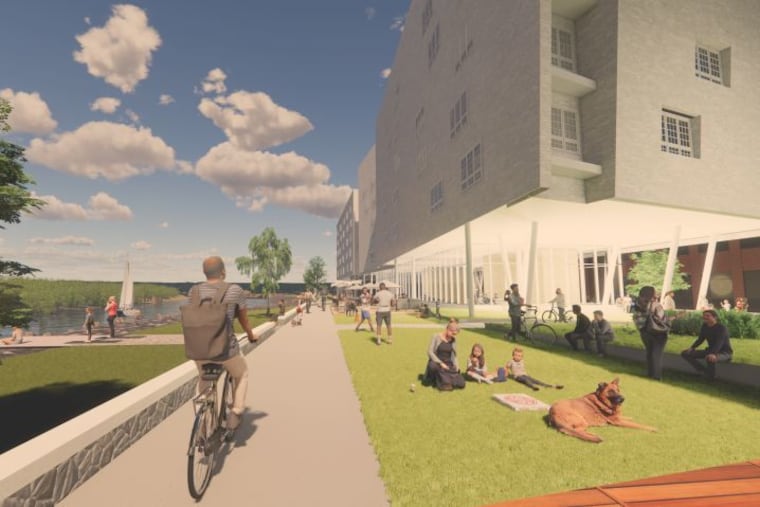More apartments, with underground parking, planned for Manayunk riverfront
A new 120-unit apartment building is proposed for Manayunk's flood-prone riverfront.

Manayunk could be getting another river-adjacent apartment complex, potentially bringing 120 units and an underground parking garage to the floodplain.
The project would feature three buildings with five residential floors, roof decks, retail on the ground floor, and storage and parking below ground. The building site, on 3900 Main St., is being developed by Michael Alhadad and is officially owned under an entity called Shahab Investment LLC. .
Three zoning variances would be required before construction: for height, because the complex would be taller than the limits in Manayunk; for use, because the lot is not zoned for homes; and for setback, because the building would not be 50 feet from the Schuylkill’s edge as required.
Neighborhood groups are confounded by the inclusion of underground parking in an area that floods so readily.
“When you look at it realistically, it just seems like a crazy scheme,” said John Hunter, zoning chair of Manayunk Neighborhood Council. “When they first came to us just floating the idea — floating is the right word — they said, ‘We’ll make it watertight.’ There’s no way to make an underground garage watertight economically.”
But zoning attorneys for the owner say that they are working with a design team with deep experience in planning projects adjacent to water. Their hired experts include an engineer who is crafting suitable climate-proofing, evacuation, and early-warning systems.
Residents will have ample time to move their vehicles ahead of encroaching waters, they say.
“Parking is at a premium, and the neighborhood wants to implement parking as part of any residential development,” said Michael Phillips, a zoning lawyer working on the project. “We’re going to do that in a responsible manner. The plan would be to get advance notice to all owners as soon as possible, if there’s a risk, to move your car somewhere else.”
Modern residential growth in Manayunk has been strong for far longer than most other Philadelphia neighborhoods, and few lots are left to build housing. The height limit that covers much of Main Street, and newly restrictive zoning along the Ridge Avenue corridor in Roxborough, could also stymie growth.
When they are proposed at all, new developments have often been targeted close to the flood-prone waterfront. Sandwiched between the Manayunk Canal and the Schuylkill, Venice Island has seen a spate of interest in recent years.
But as the effects of climate change worsen, storms like last year’s Hurricane Ida are expected to become more frequent, becoming a challenge for water-adjacent buildings.
The former owners “sold off the land 10 or 20 years ago, when the floodplain was a problem, but not really perceived as a huge problem,” said Hunter, who noted that a previous proposal for the site had attempted a line of 27 townhouses on the river’s edge.
Developers have sought to address flood risk in myriad ways. The anticipated building owners plan to have staff on site 24/7 to monitor the weather and an early-warning system to alert residents of the need to evacuate and move their cars. A similar idea has been put forward for a Venice Island proposal, although that developer would include parking on the ground floor, not underground. In both cases, residential floors would be elevated above the floodplain.
» READ MORE: More apartments proposed for Manayunk’s Venice Island a year after it was swamped by Hurricane Ida
“Owners of private property have to be able to develop and reasonably use land as long as it is well conceived,” Carl Primavera, a zoning attorney for the project, said in an email. “My brother lives in the Florida Keys and loves the lifestyle. People at the Shore feel the same way.”
The 3900 project is subject to Civic Design Review, where a municipally appointed group of architects, developers, and planners offer nonbinding critiques of proposed buildings. It will also go before the Zoning Board of Adjustment because of the multiple variances required.